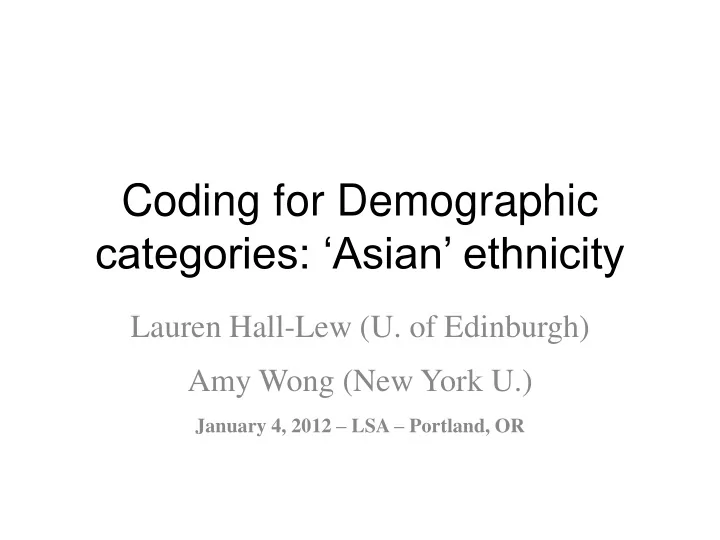

Coding for Demographic categories: ‘Asian’ ethnicity Lauren Hall-Lew (U. of Edinburgh) Amy Wong (New York U.) January 4, 2012 – LSA – Portland, OR
Challenges • Goal: a coherent conjoined set of coding conventions on demographic data to be shared by all researchers • Shared coding conventions are necessary for open- source data sharing and cross-study compatibility, but • A coding strategy that only codes at the macro-social level (e.g. “white”, “Asian American”, etc) will always misrepresent the structure of ethnicity in a given community to one degree or another: – either with respect to speaker self-identity – or with respect to broader community ideologies – or both
Challenges • Ethnicity, like other aspects of identity, will in part be constructed through the very segment of discourse that will be archived in the corpus. A speaker might orient towards different ethnicity/ethnic labels within a given interview. • Our ideal coding system should find ways to capture these nuances.
Challenges • „Asian American‟ – What level of specificity? • e.g., various types of „Asians‟ (Chinese, Filipinos, Koreans, Indians) • e.g., various types of „Chinese‟ • e.g., immigrant generation + time period of immigration – What level of generality? • community- specific associations with „Asian‟ • Mixed-race / Hapa as nonetheless „Asian‟
Goals • endeavor to more accurately reflect both the social reality of speakers‟ own identities and the community‟s identification of those speakers in the corpora; • while making such corpora more readily comparable for sociolinguistic analysis, across field sites,
Goals • to build corpora that incorporate those ethnic groups that have traditionally been overlooked in large-scale dialectological work at the moment, little is known about „Asian Americans‟ with respect to dialect studies. It is not entirely clear what levels of ethnicity and ethnic orientation matter sociolinguistically ( which is also the exciting part… )
Solutions • Recognize that the long-term goals of corpus archiving are different from immediate goals of sociolinguistic analysis. • Therefore, for corpora archiving, tag metadata in as much detail as possible, both fine- & coarse-grained – e.g., recognize that every speaker may have multiple, variable ethnic identities which are intersecting and potentially negotiated throughout a given recording.
Solutions • How to obtain this data? – questionnaires, E.g. General Ethnicity Questionnaire (GEQ) – meta comments of self-identification – close analysis of self-identification in the discourse
GEQ (Tsai, Ying and Lee 2000)
GEQ – adapted
Social Network Questionnaire (Wong 2007)
Social Network Questionnaire (Wong 2007) • Who would you contact in the hypothetical situations below? 1. You are moving apartments to another part of New York City. You need people to help you move. Who do you ask? 2. You're becoming increasingly dissatisfied with your work/study situation and are thinking of looking for a new job/program. You want to discuss the pros and cons of changing jobs/programs with someone whose opinion you value. Who do you contact?
Ethnic Orientation (The Toronto projects) Taken from Walker and Hoffman (2010)
Ethnic Orientation (The Toronto projects)
Ethnographic Interview • Basic demographic information • Heritage language competence/frequency • Childhood and schools • Neighborhood – involvement, changes • Friends • Metalinguistic comments
Complex ethnicity/ethnic orientation • “Mom was white, Dad was Filipino Chinese .” • “Dad…is of mixed background, so that's how the Filipino Chinese in me comes in.”
Fluid ethnicity/ethnic orientation • “With Asians sometimes they'll drop you off with relatives to be raised village style. And that's how I was done.”
Fluid ethnicity/ethnic orientation • “because he was born there, [Dad] knew a lot of … Filipino relatives. So as a youngster, five or so, I knew most of that side then I grew into my Chinese side .”
Fluid ethnicity/ethnic orientation • [Interviewer: “How did that happen?”] • “In the 50s there weren't many Filipinos here, there were more Chinese than there were Filipinos. And Asians tended to stick together in the fifties and sixties.”
Fluid ethnicity/ethnic orientation • “I go to China once a year (for) the last ten years … I I speak some Cantonese enough to get by.” • “that's what made our Chinese community”
Fluid ethnicity/ethnic orientation • “Both groups in those days were still are isolationist from the rest of the world. Asians, that's the way we are , but not from each other.” • “moving up in the world, just like you and I Asians , moving up in the world” • “a lot of Asians, we are conservative anyway.” • “[ be]cause I'm Asian, I wanted to do something Asian.”
Fluid ethnicity/ethnic orientation • “a lot of Filipinos say they're half Chinese. I'm a quarter .”
Aspects of Ethnicity Census Categories White Asian American National Heritage Categories Irish Chinese Locally Salient Categories Catholic Cantonese Other Group-specific Categories generation, ethnic orientation… generation, ethnic orientation…
Aspects of Ethnicity Census Categories Asian American Asian American National Heritage Categories Chinese Chinese, Filipino, Irish Locally Salient Categories Fujianese Hapa Other Group-specific Categories generation, ethnic orientation… generation, ethnic orientation…
Coding for ethnicity (Hall-Lew, ongoing)
Related Issues • Note other very closely related labels that we also need to code for: – Heritage Language • + Competence • + Frequency of Use – Generation in the U.S. • + time period of immigration • Standardized sets of interview questions/questionnaires/terminology • Protocols to include more qualitative information? – E.g. shifting identities, ethnicity of childhood peers, etc.
Recommend
More recommend